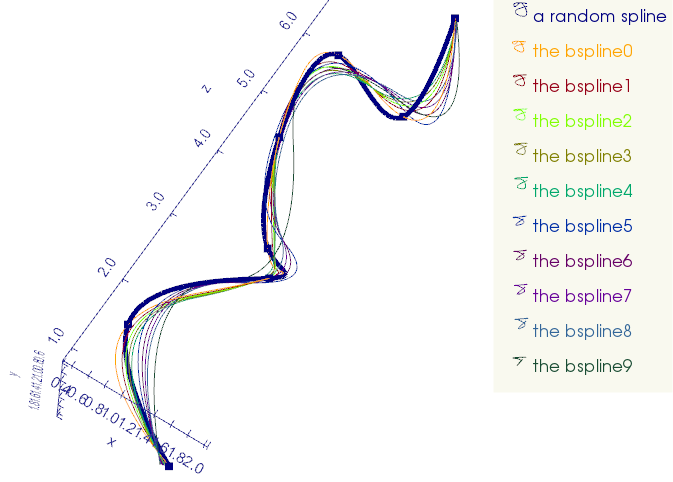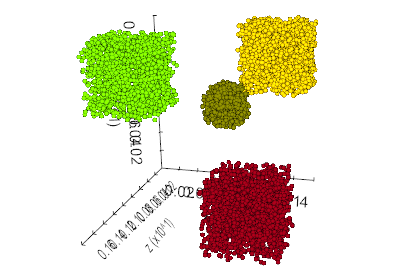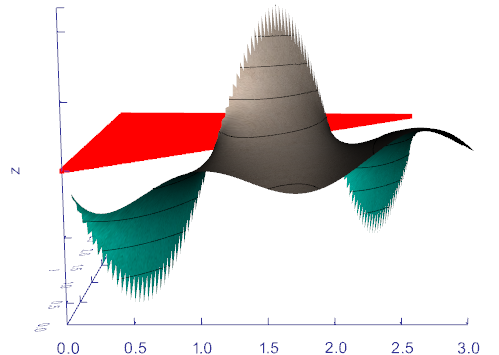def pca(points, pvalue=.95, c='c', alpha=0.5, pcaAxes=False, legend=None):
'''
Show the oriented PCA ellipsoid that contains fraction pvalue of points.
axes = True, show the 3 PCA semi axes
Extra info is stored in actor.sphericity, actor.va, actor.vb, actor.vc
(sphericity = 1 for a perfect sphere)
'''
try:
from scipy.stats import f
except:
vc.printc("Error in ellipsoid(): scipy not installed. Skip.",1)
return None
if isinstance(points, vtk.vtkActor): points=vu.coordinates(points)
if len(points) == 0: return None
P = np.array(points, ndmin=2, dtype=float)
cov = np.cov(P, rowvar=0) # covariance matrix
U, s, R = np.linalg.svd(cov) # singular value decomposition
p, n = s.size, P.shape[0]
fppf = f.ppf(pvalue, p, n-p)*(n-1)*p*(n+1)/n/(n-p) # f % point function
ua,ub,uc = np.sqrt(s*fppf)*2 # semi-axes (largest first)
center = np.mean(P, axis=0) # centroid of the hyperellipsoid
sphericity = ( ((ua-ub)/(ua+ub))**2
+ ((ua-uc)/(ua+uc))**2
+ ((ub-uc)/(ub+uc))**2 )/3. *4.
elliSource = vtk.vtkSphereSource()
elliSource.SetThetaResolution(48)
elliSource.SetPhiResolution(48)
matri = vtk.vtkMatrix4x4()
matri.DeepCopy((R[0][0] *ua, R[1][0] *ub, R[2][0] *uc, center[0],
R[0][1] *ua, R[1][1] *ub, R[2][1] *uc, center[1],
R[0][2] *ua, R[1][2] *ub, R[2][2] *uc, center[2], 0,0,0,1))
vtra = vtk.vtkTransform()
vtra.SetMatrix(matri)
ftra = vtk.vtkTransformFilter()
ftra.SetTransform(vtra)
ftra.SetInputConnection(elliSource.GetOutputPort())
ftra.Update()
actor_elli = vu.makeActor(ftra.GetOutput(), c, alpha, legend=legend)
actor_elli.GetProperty().BackfaceCullingOn()
actor_elli.GetProperty().SetInterpolationToPhong()
if pcaAxes:
axs = []
for ax in ([1,0,0], [0,1,0], [0,0,1]):
l = vtk.vtkLineSource()
l.SetPoint1([0,0,0])
l.SetPoint2(ax)
l.Update()
t = vtk.vtkTransformFilter()
t.SetTransform(vtra)
vu.setInput(t, l.GetOutput())
t.Update()
axs.append(vu.makeActor(t.GetOutput(), c, alpha))
finact = vu.makeAssembly([actor_elli]+axs, legend=legend)
else :
finact = actor_elli
setattr(finact, 'sphericity', sphericity)
setattr(finact, 'va', ua)
setattr(finact, 'vb', ub)
setattr(finact, 'vc', uc)
return finact
def smoothMLS1D(actor, f=0.2, showNLines=0):
'''
Smooth actor or points with a Moving Least Squares variant.
The list actor.variances contain the residue calculated for each point.
Input actor's polydata is modified.
f, smoothing factor - typical range s [0,2]
showNLines, build an actor showing the fitting line for N random points
'''
coords = vu.coordinates(actor)
ncoords = len(coords)
Ncp = int(ncoords * f / 10)
nshow = int(ncoords)
if showNLines: ndiv = int(nshow / showNLines)
if Ncp < 3:
vc.printc('Please choose a higher fraction than ' + str(f), 1)
Ncp = 3
poly = vu.polydata(actor, True)
vpts = poly.GetPoints()
locator = vtk.vtkPointLocator()
locator.SetDataSet(poly)
locator.BuildLocator()
vtklist = vtk.vtkIdList()
variances, newline, acts = [], [], []
for i, p in enumerate(coords):
locator.FindClosestNPoints(Ncp, p, vtklist)
points = []
for j in range(vtklist.GetNumberOfIds()):
trgp = [0, 0, 0]
vpts.GetPoint(vtklist.GetId(j), trgp)
points.append(trgp)
if len(points) < 2: continue
points = np.array(points)
pointsmean = points.mean(axis=0) # plane center
uu, dd, vv = np.linalg.svd(points - pointsmean)
newp = np.dot(p - pointsmean, vv[0]) * vv[0] + pointsmean
variances.append(dd[1] + dd[2])
newline.append(newp)
if showNLines and not i % ndiv:
fline = fitLine(points, lw=4, alpha=1) # fitting plane
iapts = vs.points(points) # blue points
acts += [fline, iapts]
for i in range(ncoords):
vpts.SetPoint(i, newline[i])
if showNLines:
apts = vs.points(newline, c='r 0.6', r=2)
ass = vu.makeAssembly([apts] + acts)
return ass #NB: a demo actor is returned
setattr(actor, 'variances', np.array(variances))
return actor #NB: original actor is modified
def spline(points, smooth=0.5, degree=2,
s=2, c='b', alpha=1., nodes=False, legend=None, res=20):
'''
Return a vtkActor for a spline that doesnt necessarly pass exactly throught all points.
Options:
smooth, smoothing factor:
0 = interpolate points exactly,
1 = average point positions
degree = degree of the spline (1<degree<5)
nodes = True shows also original the points
[**Example**](https://github.com/marcomusy/vtkplotter/blob/master/examples/tutorial.py)

'''
try:
from scipy.interpolate import splprep, splev
except ImportError:
vc.printc(
'Warning: ..scipy not installed, using vtkCardinalSpline instead.', c=5)
return _vtkspline(points, s, c, alpha, nodes, legend, res)
Nout = len(points)*res # Number of points on the spline
points = np.array(points)
minx, miny, minz = np.min(points, axis=0)
maxx, maxy, maxz = np.max(points, axis=0)
maxb = max(maxx-minx, maxy-miny, maxz-minz)
smooth *= maxb/2 # must be in absolute units
x, y, z = points[:, 0], points[:, 1], points[:, 2]
tckp, _ = splprep([x, y, z], task=0, s=smooth, k=degree) # find the knots
# evaluate spline, including interpolated points:
xnew, ynew, znew = splev(np.linspace(0, 1, Nout), tckp)
ppoints = vtk.vtkPoints() # Generate the polyline for the spline
profileData = vtk.vtkPolyData()
for i in range(Nout):
ppoints.InsertPoint(i, xnew[i], ynew[i], znew[i])
lines = vtk.vtkCellArray() # Create the polyline
lines.InsertNextCell(Nout)
for i in range(Nout):
lines.InsertCellPoint(i)
profileData.SetPoints(ppoints)
profileData.SetLines(lines)
actline = vu.makeActor(profileData, c=c, alpha=alpha, legend=legend)
actline.GetProperty().SetLineWidth(s)
if nodes:
actnodes = vs.points(points, r=5, c=c, alpha=alpha)
ass = vu.makeAssembly([actline, actnodes], legend=legend)
return ass
else:
return actline
def makeHandActor(self, f=1):
a1, a2, a3, c = (10*f,0,0), (0,7*f,0), (0,0,3*f), (.7,0.3,0.3)
palm = ellipsoid(pos=(0,-3,0), axis1=a1, axis2=a2, axis3=a3, alpha=0.6, c=c)
wrist= box(pos=(0,-9,0), length=6*f, width=5, height=2, alpha=0.4, c=c)
arm = makeAssembly([palm,wrist])
self.vp.actors.append(arm) # add actor to internal list
f1 = self.vp.cylinder((-2, 1.5,0), axis=(0,1,0), height=5, r=.8*f, c=c)
f2 = self.vp.cylinder((-1, 3 ,0), axis=(0,1,0), height=6, r=.7*f, c=c)
f3 = self.vp.cylinder(( 0, 4 ,0), axis=(0,1,0), height=6.2, r=.75*f, c=c)
f4 = self.vp.cylinder(( 1, 3.5,0), axis=(0,1,0), height=6.1, r=.7*f, c=c)
f5 = self.vp.cylinder(( 2, 2 ,0), axis=(0,1,0), height=5, r=.6*f, c=c)
return [arm, f1,f2,f3,f4,f5]
def cluster(points, radius, legend=None):
'''
Clustering of points in space.
radius, is the radius of local search.
Individual subsets can be accessed through actor.clusters
[**Example**](https://github.com/marcomusy/vtkplotter/blob/master/examples/basic/clustering.py)

'''
if isinstance(points, vtk.vtkActor):
poly = vu.polydata(points)
else:
src = vtk.vtkPointSource()
src.SetNumberOfPoints(len(points))
src.Update()
vpts = src.GetOutput().GetPoints()
for i, p in enumerate(points):
vpts.SetPoint(i, p)
poly = src.GetOutput()
cluster = vtk.vtkEuclideanClusterExtraction()
vu.setInput(cluster, poly)
cluster.SetExtractionModeToAllClusters()
cluster.SetRadius(radius)
cluster.ColorClustersOn()
cluster.Update()
idsarr = cluster.GetOutput().GetPointData().GetArray('ClusterId')
Nc = cluster.GetNumberOfExtractedClusters()
sets = [[] for i in range(Nc)]
for i, p in enumerate(points):
sets[idsarr.GetValue(i)].append(p)
acts = []
for i, aset in enumerate(sets):
acts.append(vs.points(aset, c=i))
actor = vu.makeAssembly(acts, legend=legend)
setattr(actor, 'clusters', sets)
print('Nr. of extracted clusters', Nc)
if Nc > 10:
print('First ten:')
for i in range(Nc):
if i > 9:
print('...')
break
print('Cluster #'+str(i)+', N =', len(sets[i]))
print('Access individual clusters through attribute: actor.cluster')
return actor
def cluster(points, radius, legend=None):
'''
Clustering of points in space.
radius, is the radius of local search.
Individual subsets can be accessed through actor.clusters
'''
if isinstance(points, vtk.vtkActor):
poly = vu.polydata(points)
else:
src = vtk.vtkPointSource()
src.SetNumberOfPoints(len(points))
src.Update()
vpts = src.GetOutput().GetPoints()
for i, p in enumerate(points):
vpts.SetPoint(i, p)
poly = src.GetOutput()
cluster = vtk.vtkEuclideanClusterExtraction()
vu.setInput(cluster, poly)
cluster.SetExtractionModeToAllClusters()
cluster.SetRadius(radius)
cluster.ColorClustersOn()
cluster.Update()
idsarr = cluster.GetOutput().GetPointData().GetArray('ClusterId')
Nc = cluster.GetNumberOfExtractedClusters()
sets = [[] for i in range(Nc)]
for i, p in enumerate(points):
sets[idsarr.GetValue(i)].append(p)
acts = []
for i, aset in enumerate(sets):
acts.append(vs.points(aset, c=i))
actor = vu.makeAssembly(acts, legend=legend)
setattr(actor, 'clusters', sets)
print('Nr. of extracted clusters', Nc)
if Nc > 10: print('First ten:')
for i in range(Nc):
if i > 9:
print('...')
break
print('Cluster #' + str(i) + ', N =', len(sets[i]))
print('Access individual clusters through attribute: actor.cluster')
return actor
def load3DS(filename, legend):
renderer = vtk.vtkRenderer()
renWin = vtk.vtkRenderWindow()
renWin.AddRenderer(renderer)
importer = vtk.vtk3DSImporter()
importer.SetFileName(filename)
importer.ComputeNormalsOn()
importer.SetRenderWindow(renWin)
importer.Update()
actors = renderer.GetActors() # vtkActorCollection
acts = []
for i in range(actors.GetNumberOfItems()):
a = actors.GetItemAsObject(i)
acts.append(a)
del renWin
return vu.makeAssembly(acts, legend=legend)
def _vtkspline(points, s, c, alpha, nodes, legend, res):
numberOfOutputPoints = len(points)*res # Number of points on the spline
numberOfInputPoints = len(points) # One spline for each direction.
aSplineX = vtk.vtkCardinalSpline() # interpolate the x values
aSplineY = vtk.vtkCardinalSpline() # interpolate the y values
aSplineZ = vtk.vtkCardinalSpline() # interpolate the z values
inputPoints = vtk.vtkPoints()
for i in range(0, numberOfInputPoints):
x = points[i][0]
y = points[i][1]
z = points[i][2]
aSplineX.AddPoint(i, x)
aSplineY.AddPoint(i, y)
aSplineZ.AddPoint(i, z)
inputPoints.InsertPoint(i, x, y, z)
inputData = vtk.vtkPolyData()
inputData.SetPoints(inputPoints)
points = vtk.vtkPoints()
profileData = vtk.vtkPolyData()
for i in range(0, numberOfOutputPoints):
t = (numberOfInputPoints-1.)/(numberOfOutputPoints-1.)*i
x, y, z = aSplineX.Evaluate(
t), aSplineY.Evaluate(t), aSplineZ.Evaluate(t)
points.InsertPoint(i, x, y, z)
lines = vtk.vtkCellArray() # Create the polyline.
lines.InsertNextCell(numberOfOutputPoints)
for i in range(0, numberOfOutputPoints):
lines.InsertCellPoint(i)
profileData.SetPoints(points)
profileData.SetLines(lines)
actline = vu.makeActor(profileData, c=c, alpha=alpha, legend=legend)
actline.GetProperty().SetLineWidth(s)
actline.GetProperty().SetInterpolationToPhong()
if nodes:
pts = vu.coordinates(inputData)
actnodes = vs.points(pts, r=s*1.5, c=c, alpha=alpha)
ass = vu.makeAssembly([actline, actnodes], legend=legend)
return ass
else:
return actline
def normals(actor, ratio=5, c=(0.6, 0.6, 0.6), alpha=0.8, legend=None):
'''
Build a vtkActor made of the normals at vertices shown as arrows
[**Example1**](https://github.com/marcomusy/vtkplotter/blob/master/examples/tutorial.py)
[**Example2**](https://github.com/marcomusy/vtkplotter/blob/master/examples/advanced/fatlimb.py)
'''
maskPts = vtk.vtkMaskPoints()
maskPts.SetOnRatio(ratio)
maskPts.RandomModeOff()
src = vu.polydata(actor)
vu.setInput(maskPts, src)
arrow = vtk.vtkArrowSource()
arrow.SetTipRadius(0.075)
glyph = vtk.vtkGlyph3D()
glyph.SetSourceConnection(arrow.GetOutputPort())
glyph.SetInputConnection(maskPts.GetOutputPort())
glyph.SetVectorModeToUseNormal()
b = src.GetBounds()
sc = max([b[1]-b[0], b[3]-b[2], b[5]-b[4]])/20.
glyph.SetScaleFactor(sc)
glyph.SetColorModeToColorByVector()
glyph.SetScaleModeToScaleByVector()
glyph.OrientOn()
glyph.Update()
glyphMapper = vtk.vtkPolyDataMapper()
glyphMapper.SetInputConnection(glyph.GetOutputPort())
glyphMapper.SetScalarModeToUsePointFieldData()
glyphMapper.SetColorModeToMapScalars()
glyphMapper.ScalarVisibilityOn()
glyphMapper.SelectColorArray("Elevation")
glyphActor = vtk.vtkActor()
glyphActor.SetMapper(glyphMapper)
glyphActor.GetProperty().EdgeVisibilityOff()
glyphActor.GetProperty().SetColor(vc.getColor(c))
# check if color string contains a float, in this case ignore alpha
al = vc.getAlpha(c)
if al:
alpha = al
glyphActor.GetProperty().SetOpacity(alpha)
aactor = vu.makeAssembly([actor, glyphActor], legend=legend)
return aactor
def smoothMLS2D(actor, f=0.2, decimate=1, recursive=0, showNPlanes=0):
'''
Smooth actor or points with a Moving Least Squares variant.
The list actor.variances contain the residue calculated for each point.
Input actor's polydata is modified.
Options:
f, smoothing factor - typical range s [0,2]
decimate, decimation factor (an integer number)
recursive, move points while algorithm proceedes
showNPlanes, build an actor showing the fitting plane for N random points
[**Example1**](https://github.com/marcomusy/vtkplotter/blob/master/examples/advanced/mesh_smoothers.py)
[**Example2**](https://github.com/marcomusy/vtkplotter/blob/master/examples/advanced/moving_least_squares2D.py)
[**Example3**](https://github.com/marcomusy/vtkplotter/blob/master/examples/advanced/recosurface.py)
'''
coords = vu.coordinates(actor)
ncoords = len(coords)
Ncp = int(ncoords*f/100)
nshow = int(ncoords/decimate)
if showNPlanes:
ndiv = int(nshow/showNPlanes*decimate)
if Ncp < 5:
vc.printc('Please choose a higher fraction than '+str(f), c=1)
Ncp = 5
print('smoothMLS: Searching #neighbours, #pt:', Ncp, ncoords)
poly = vu.polydata(actor, True)
vpts = poly.GetPoints()
locator = vtk.vtkPointLocator()
locator.SetDataSet(poly)
locator.BuildLocator()
vtklist = vtk.vtkIdList()
variances, newsurf, acts = [], [], []
pb = vio.ProgressBar(0, ncoords)
for i, p in enumerate(coords):
pb.print('smoothing...')
if i % decimate:
continue
locator.FindClosestNPoints(Ncp, p, vtklist)
points = []
for j in range(vtklist.GetNumberOfIds()):
trgp = [0, 0, 0]
vpts.GetPoint(vtklist.GetId(j), trgp)
points.append(trgp)
if len(points) < 5:
continue
points = np.array(points)
pointsmean = points.mean(axis=0) # plane center
uu, dd, vv = np.linalg.svd(points-pointsmean)
a, b, c = np.cross(vv[0], vv[1]) # normal
d, e, f = pointsmean # plane center
x, y, z = p
t = (a*d - a*x + b*e - b*y + c*f - c*z) # /(a*a+b*b+c*c)
newp = [x+t*a, y+t*b, z+t*c]
variances.append(dd[2])
newsurf.append(newp)
if recursive:
vpts.SetPoint(i, newp)
if showNPlanes and not i % ndiv:
plane = fitPlane(points, alpha=0.3) # fitting plane
iapts = vs.points(points) # blue points
acts += [plane, iapts]
if decimate == 1 and not recursive:
for i in range(ncoords):
vpts.SetPoint(i, newsurf[i])
setattr(actor, 'variances', np.array(variances))
if showNPlanes:
apts = vs.points(newsurf, c='r 0.6', r=2)
ass = vu.makeAssembly([apts]+acts)
return ass # NB: a demo actor is returned
return actor # NB: original actor is modified
def fxy(z='sin(3*x)*log(x-y)/3', x=[0, 3], y=[0, 3],
zlimits=[None, None], showNan=True, zlevels=10, wire=False,
c='b', bc='aqua', alpha=1, legend=True, texture=None, res=100):
'''
Build a surface representing the 3D function specified as a string
or as a reference to an external function.
Red points indicate where the function does not exist (showNan).
zlevels will draw the specified number of z-levels contour lines.
[**Example**](https://github.com/marcomusy/vtkplotter/blob/master/examples/basic/fxy.py)

'''
if isinstance(z, str):
try:
z = z.replace('math.', '').replace('np.', '')
namespace = locals()
code = "from math import*\ndef zfunc(x,y): return "+z
exec(code, namespace)
z = namespace['zfunc']
except:
vc.printc('Syntax Error in fxy()', c=1)
return None
ps = vtk.vtkPlaneSource()
ps.SetResolution(res, res)
ps.SetNormal([0, 0, 1])
ps.Update()
poly = ps.GetOutput()
dx = x[1]-x[0]
dy = y[1]-y[0]
todel, nans = [], []
if zlevels:
tf = vtk.vtkTriangleFilter()
vu.setInput(tf, poly)
tf.Update()
poly = tf.GetOutput()
for i in range(poly.GetNumberOfPoints()):
px, py, _ = poly.GetPoint(i)
xv = (px+.5)*dx+x[0]
yv = (py+.5)*dy+y[0]
try:
zv = z(xv, yv)
poly.GetPoints().SetPoint(i, [xv, yv, zv])
except:
todel.append(i)
nans.append([xv, yv, 0])
if len(todel):
cellIds = vtk.vtkIdList()
poly.BuildLinks()
for i in todel:
poly.GetPointCells(i, cellIds)
for j in range(cellIds.GetNumberOfIds()):
poly.DeleteCell(cellIds.GetId(j)) # flag cell
poly.RemoveDeletedCells()
cl = vtk.vtkCleanPolyData()
vu.setInput(cl, poly)
cl.Update()
poly = cl.GetOutput()
if not poly.GetNumberOfPoints():
vc.printc('Function is not real in the domain', c=1)
return vtk.vtkActor()
if zlimits[0]:
a = vu.cutPlane(poly, (0, 0, zlimits[0]), (0, 0, 1))
poly = vu.polydata(a)
if zlimits[1]:
a = vu.cutPlane(poly, (0, 0, zlimits[1]), (0, 0, -1))
poly = vu.polydata(a)
if c is None:
elev = vtk.vtkElevationFilter()
vu.setInput(elev, poly)
elev.Update()
poly = elev.GetOutput()
actor = vu.makeActor(poly, c=c, bc=bc, alpha=alpha, wire=wire,
legend=legend, texture=texture)
acts = [actor]
if zlevels:
elevation = vtk.vtkElevationFilter()
vu.setInput(elevation, poly)
bounds = poly.GetBounds()
elevation.SetLowPoint(0, 0, bounds[4])
elevation.SetHighPoint(0, 0, bounds[5])
elevation.Update()
bcf = vtk.vtkBandedPolyDataContourFilter()
vu.setInput(bcf, elevation.GetOutput())
bcf.SetScalarModeToValue()
bcf.GenerateContourEdgesOn()
bcf.GenerateValues(zlevels, elevation.GetScalarRange())
bcf.Update()
zpoly = bcf.GetContourEdgesOutput()
zbandsact = vu.makeActor(zpoly, c='k', alpha=alpha)
zbandsact.GetProperty().SetLineWidth(1.5)
acts.append(zbandsact)
if showNan and len(todel):
bb = actor.GetBounds()
zm = (bb[4]+bb[5])/2
nans = np.array(nans)+[0, 0, zm]
nansact = vs.points(nans, c='red', alpha=alpha/2)
acts.append(nansact)
if len(acts) > 1:
asse = vu.makeAssembly(acts)
return asse
else:
return actor
